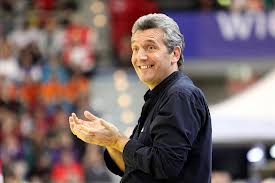
French coach Onesta, seemingly clueless about the reasons for the French decline, or simply unable to make the team perform?
This timing is clearly the worst aspect of the existing competition calendar with five ‘big events’ in four years. So this may have contributed to the unusual extent of injuries, and it also explains why some top players found this the right moment to retire. But it simply also reflects fatigue, both physical and mental, and the difficulty in being in peak form for two events so close together. And it is ‘interesting’ that this problem is highlighted right at the moment when the Europeans are under the ‘cloud’ of the proposal of introducing ‘European Games’ as one more big event in every four-year period…
But there are also questions about the impact of the tournament format. Most of the debate tends to be about the pros and cons of having a ‘main round’ as opposed to the format now used with ‘knock-out games’ starting from the round of 16. Some also have views on the advantages of four groups with six teams vs. six groups with four teams. But personally I sense that the real issue is having an event with so many games between strong and weak teams. This makes it more difficult to keep concentration and maintain a strong and consistent level.
Clearly it is not realistic and appropriate to propose a reduction or to raise the issue of having an ‘A’ and a ‘B’ World Championship as on some occasions in the past. It is a global event and there has to be room for at least a few participants from each continent. But the current format puts a burden in terms of the pure number of games for the top teams, and it has too many uneven games. Yes, the non-European teams want to measure themselves against the Europeans, but how beneficial is it to play several of those 13-38 or 16-43 games before it is time for the President’s Cup? I think one needs to consider a radically different format!
How would it be to allow the eight top seeded teams to stay out of a first phase!? Bring the teams ranked 9-24 into a preliminary round with four groups of four teams. This allows the non-European teams a chance to play opponents from all other continents, including Europe. And then the two bottom teams from each group move on to the President’s Cup, while the top two get to play the seeded teams, with a main round of 16 teams having four groups of four teams. From there on, you move on to quarterfinals for the top teams and placement games for the others.
Not everyone may immediately agree, but to my way of thinking, this amounts to retaining the advantages of the current format while reducing the negative aspects. And I am sure that both our readers and the responsible persons in the IHF and national federations could come up with even better ideas, if there was just a readiness to think ‘outside the box’.
